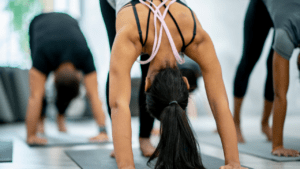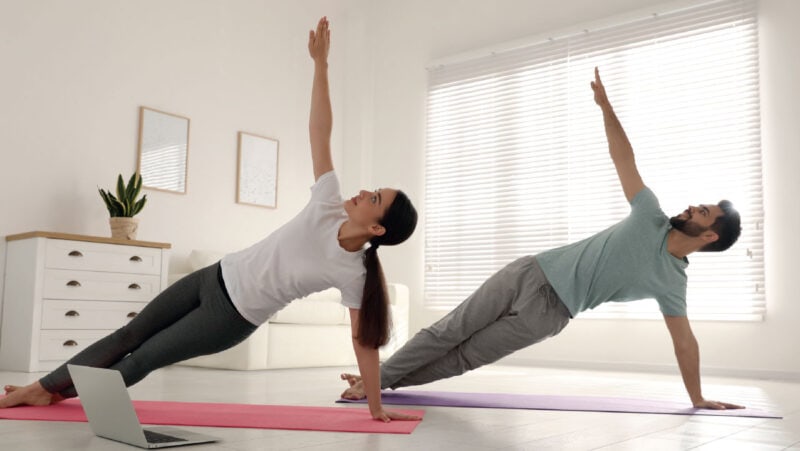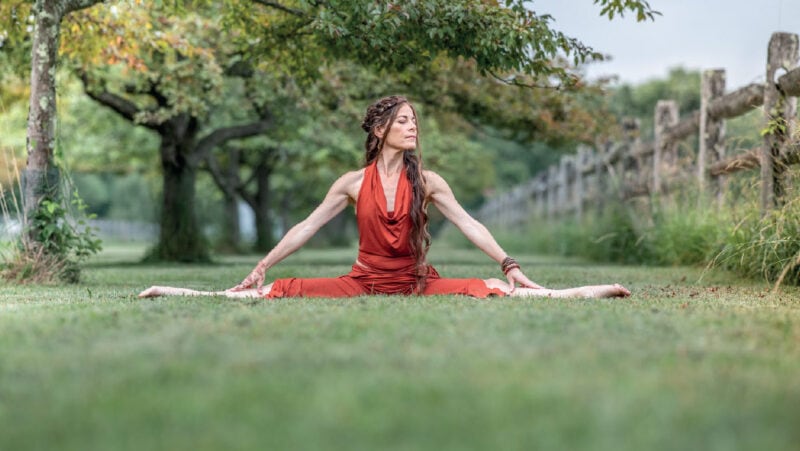
5 ways that yoga can help with stress
When we are constantly in a state of stress, it can be hard to take back control and allow ourselves time to recover. Yoga can help! By Catherine Morrison
It took me a long time to decide what to write about in this article… I just couldn’t clear my mind! I have been busy at work, dealing with sickness, arranging quotes with builders, sorting out my tax, paying the childminder, visiting family, keeping the children alive – I’m sure you can see where I am going with this!
All very much first-world problems – and I am eternally grateful that my time on the earth right now is where I am. However, sometimes this fast-paced life of ours is super busy and very stressful.
My personal experience of getting through the stressful times and finding some perspective when life feels like it is getting too much is that if I practice even a little bit of yoga each day, then things always seem much better.
What is stress?
We hear so much about it. It is subjective; what stresses one person out is something that might not affect someone else. However, one fact remains: the 'stress' we experience is a bodily chemical reaction that happens in response to a perceived threat. And it is 'perceived' that is the key word here – what we believe is a threat to us, either physically or mentally. This may be a conscious response to physical danger (feeling scared standing at the edge of a cliff) or an unconscious response that you might not even know you are having. Unless we explore these subconscious fears and unlock them, they will probably stress us (and others) out for a long time to come.
Physiologically, when our brain assesses the threat situation, it communicates with the rest of our bodies via the Autonomic Nervous System, which is made up of the Sympathetic (fight, flight or freeze) and the Parasympathetic (rest and digest) Nervous Systems.
When we are in danger mode, we need more energy to deal with whatever situation we find ourselves in. Adrenalin kicks in, causing our heart to speed up and pump more blood around the body; we breathe faster to get more oxygen, and sugars and fats are sent from our reserves to the bits of the body where they are most needed. We are more alert; our senses are sharper and, temporarily, we are superheroes and ready for a fight. A very useful response when you are being chased by the proverbial sabre-toothed tiger, but probably not as necessary when you are picking up the kids from school.
While the body is busy putting all of its efforts into getting out of danger, other vital systems (such as the digestive and immune systems) get put on the back burner. This means that we need to be back in safety and in a relaxed state before we can continue to function as normal.
So when we are constantly in this 'stress' state, it is hard to take back control and allow ourselves time to recover. Eventually, we become exhausted and experience various physical, physiological and social symptoms.
Chronic stress also affects mental health. One study found that we produce brain cells differently in times of stress, disrupting the timing and balance of communication between our brains and our bodies. Research has also shown that stress can have negative effects on memory and learning.
Without going into the realms of good and bad stress, it is generally not a good thing for your body and mind to be in a constant state of high alert, for all the reasons outlined above and many more.
So how can yoga help to deal with stress?
 Movement
Movement
We all know that exercise releases endorphins, which are naturally produced chemicals that help to relieve pain and make us feel happy. Practicing physical yoga also releases endorphins, and (usually) you don’t have to push yourself to your limits to get these benefits
Yoga poses encourage the blood to flow, meaning that our vital organs get the nutrients and energy they need. Research has found that during a yoga session the joints of the body are being taken through their full range of motion. This can help to alleviate pain as well as help conditions like arthritis or carpal tunnel syndrome.
Yoga helps to break the pain cycle by encouraging movement and by giving us confidence that, little by little, we can start to find more flexibility and get more in tune with our bodies as a whole.
There are phrases such as 'carrying the weight of the world on your shoulders' which have been passed down through generations. Therapists from all around the globe can attest to times when touching or releasing a body part will bring a person to tears, and yoga teachers have reported similar situations with students during practice. The movement toward this kind of therapy in western medicine for help with PTSD and other mental health conditions points to a growing understanding that we are bigger than our body parts – and that a more holistic attitude towards healing is needed.
The 'whole-body' approach to movement, which is at the forefront of a physical yoga session, helps people to find areas of tightness in their bodies and work to release them. Often this brings with it a release of stress and promotes a better sense of wellbeing.
 Breathing
Breathing
Being aware of how you breathe, and practicing slow deep breathing, activates your Parasympathetic System. In some yoga disciplines, you might be using different types of breath-work to get a more conscious response around triggering the Sympathetic System, using techniques such as breath retention. These types of exercises don’t feel relaxing at the time of doing them – but training your brain to have conscious control over a perceived threat allows you to have a more controlled stress response in everyday situations.
Meditation
Meditating is a key part of yoga; not only traditional seated meditation but also during the practice when essentially yoga is meditation as movement. When we are focusing on our breathing and turning our attention inwards during practice, we are also reaping the benefits of meditation as we go.
Meditation helps us to get to know ourselves better. With regular mediation practice, we are more likely to become aware of any ingrained subconscious 'markers' that have defined how we act and react to situations. Once we notice them, we have more power to start to be able to take charge of them.
Chanting
Love it or hate it, chanting is part of Yoga, even if it is just the occasional 'Ohm'. Chanting itself is ancient – all modern music is based on it and the general consensus is that for most of us, there is at least one type of music that just hearing makes us feel good. A study looking into the effects of chanting on wellbeing found that chanting in a group increased feelings of social cohesion, and that chanting in general “… focused attention, which may inhibit ruminative thinking and lead to increased positive mood.”
Furthermore, studies into chanting and wellbeing have found that chanting increases positive mood and that the vibration in the vocal chords when chanting 'Ohm' stimulates the Parasympathetic System – getting us nice and relaxed.
Philosophy
As we are talking about how yoga can help stress – it would be remiss not to mention philosophy and history.
Any amount of reading that takes you beyond the yoga poses and into the ancient traditions pretty much shows why so many people are drawn to practicing yoga as an escape from our busy modern lives. Yoga wasn’t (and isn’t) always the purely physical practice that is prevalent in Western culture today, and the core principle of not causing suffering in yourself or others is still very much alive. Stress is probably one of the biggest self-induced sufferings that modern people put upon themselves.
And, if you started to consider bringing the concepts of the Yamas (don’t hurt anything, be truthful, be happy with what you have, look after what you have and don’t be greedy) and the Niyamas (be clean, be content, keep learning and give everything 100%) into your day-to-day life; you would find navigating your way through the tricky decisions that we need to make in everyday life a lot less stressful.
Can yoga cause stress?
Yoga, like anything else, can be added to 'the list' of things you need to do each day. The more obsessive/compulsive types amongst us start to feel anxiety if they haven’t 'done their yoga' for the day which can cause additional stress.
We can push ourselves too hard and even cause physical injury. We should always work at a level that feels right – focus on alignment over full posture – and don’t do anything that hurts. Practicing acceptance and gratitude at the end of each session allows us to let go of any negative emotions, recognise our achievements and give ourselves a well-earned pat on the back for just turning up.
“Yoga is not about touching your toes, it’s about what you learn on the way down.” — Jigar Gor
To sum up, for me, practicing yoga is probably the one thing I can do that can pretty much guarantee I will see life from a much better perspective. And the more I practice, the more chilled, happy, and nice to be around I am.
And when I was trying to figure out what to write about today, instead of staring out the window and chewing anxiously on the end of a pencil – I should have taken a deep breath, and rolled out the mat.
“Yoga allows you to find an inner peace that is not ruffled and riled by the endless stresses and struggles of life” – BKS Iyengar.







